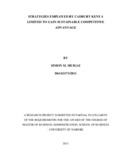| dc.description.abstract | An organization's success is environment depended. Organization functions within the
environment. The environment offers opportunities and poses threats to an organization
depending on the capabilities of the organization. For an organization to survive it has to
pay keen attention to its environment. Thomson et al (2010) posits that a company's
competitive strategy deals exclusively with the specifics of management plan for
competing successfully. Barney and Hesterly (2008), posits that the ultimate objective of
the strategic management process is to enable a firm to choose and implement a strategy
that generates a competitive advantage. In general, a firm has a competitive advantage
when it is able to create more economic value than rivals. The study set out to address
two objectives namely to establish the strategies CKL had used to create sustainable
competitive advantage and to establish the challenges CKL faced in pursuit of creating
sustainable advantage. This study made use of both primary and secondary data. Primary
data was collected through in-depth interviews with the senior management at CKL.
Secondary data was obtained from the company's records such as financial statements
and in-house magazines and publications. A content analysis was performed on the data
to allow for an in-depth understanding of issues in the case. The study found out that
CKL had periodic strategic plans. The review period was found to be every 5 years.
Strategies are normally developed by the global corporate company - Mondelez
International, cascaded into a local strategy and implemented based on the local setup.
The study established there had been many changes in the external environment variables
though CKL was able to respond to most of them. In the political framework the
company faced various challenges prior to the 2007 and 2013 elections because the
environment was harsh in doing business. In the legal environment, the key variable had
been taxation. In the technological environment, the key changes were due to innovation
which was mainly driven internally by the global company. This led to development of
Centers for Excellence for specific manufacturing for affordability of the technology,
economies of scale and for better value creation. Economic factors which affected CKL
include reduced capital outlay, high interest rates and high cost of electricity. In the
competitive environment, key variables were the barrier of entry is high, bargaining
power of suppliers and buyers fairly very low and availability of cheap raw materials
from China, Asia and some local companies. The study suggested that in order to
understand strategies possible for these environmental changes, further studies are
required in other companies in the industry to get a holistic view. A further study could
be canied out to gain a full understanding why CKL chose these strategies and to
establish if there are other strategies CKL could have used. Lastly, further studies could
be done to establish how CKL can alter these strategies so as to respond to the imminent
environmental changes in future. This study concludes that, even for companies that were
successful, it is prudent that they continuously engage in strategies that are aligned and
match with the changes in the external environment to create sustainable competitive
advantage. Organizations also need to selfishly guard its core competencies and unique
resources to be able to create a sustainable competitive advantage. | en_US |

